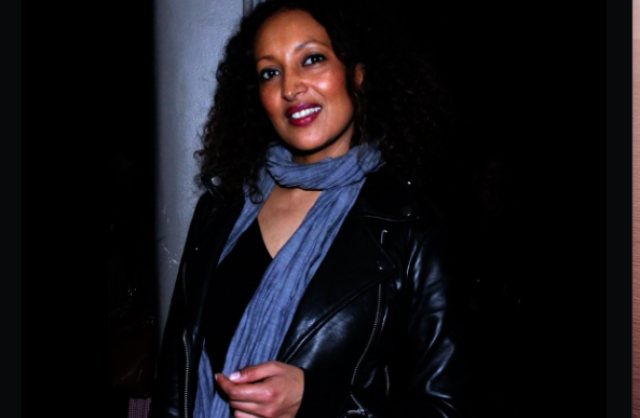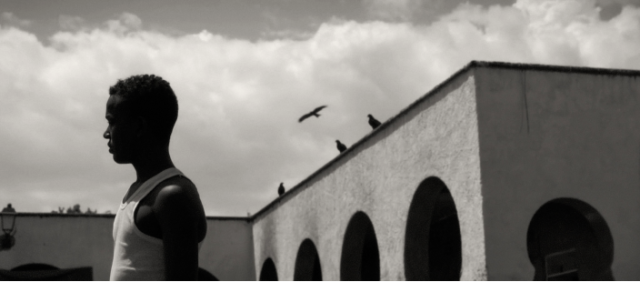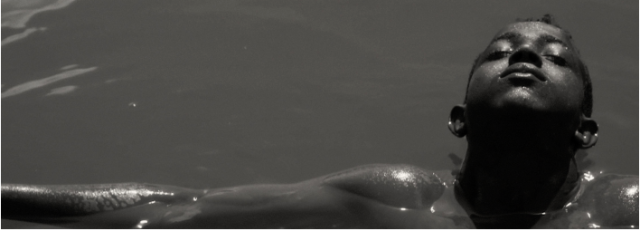 Next month on October 01, 2021 Jessica Beshir will participate in a Q&A session with the audience following the screening of her documentary 'Faya Dayi' by the American Film Institute at AFI Silver Theatre and Cultural Center in Silver Spring, Maryland. (Photo via Linkedin)
Next month on October 01, 2021 Jessica Beshir will participate in a Q&A session with the audience following the screening of her documentary 'Faya Dayi' by the American Film Institute at AFI Silver Theatre and Cultural Center in Silver Spring, Maryland. (Photo via Linkedin)
Tadias Magazine
By Tadias Staff
Updated: September 23rd, 2021
New York (TADIAS) — One of the marks of a successful movie is the lively conversations and reactions it generates among its audience as Filmmaker Jessica Beshir’s Sundance-premiered Ethiopian film Faya Dayi continues to do on social media and other forums.
Next month Jessica Beshir will participate in a Q&A with the public following the screening of her documentary by the American Film Institute at AFI Silver Theatre and Cultural Center in Silver Spring, Maryland.
“A film ten years in the making, Faya Dayi was conceived by director Jessica Beshir as an act of reconnecting with the Ethiopian homeland she left at the age of sixteen, when her family fled to Mexico to escape the chaos and oppression of the Mengistu and Derg political regimes,” the announcement notes. “Later, in 2011, during one of her return trips to Ethiopia, Beshir began collecting observations and impressions of the country by shooting footage that told the stories of several Ethiopians and the social, religious, and economic forces influencing their lives.”
The press release adds: “Among those forces was the ascendency of khat [ጫት ch'at] as a national cash crop. A plant with hallucinatory properties that has been traditionally harvested and chewed for ritualistic purposes, khat was, in Beshir’s youth, one of many lucrative crops bolstering the Ethiopian economy. But in the intervening years, climate change, along with other factors, had forced farmers to grow khat to the near exclusion of all other plants, and its excessive presence in the country increased recreational khat usage among the younger generations. Climate change had also dried up lakes, while economic necessity and political tumult had forced people living in rural areas to look for new prospects overseas or in the capital city of Addis Ababa.”
In explaining her experience of cinema while growing up in Ethiopia and what led her to become a filmmaker Jessica recalls that she was raised in a military camp located adjacent to a Russian military base in Harar. “In the Russian camp, there was an open-air movie theater,” she rememberers. “Us kids dug a hole under the barbed wire and snuck through it to the movie theater.”
She continues: “We’d go there every night to watch Russian films—mostly war films that were meant to elevate the morale of the Russian soldiers stationed in Ethiopia. One of our friends was trained by the Russians to project the films. He would change the reels of the films in the back of a Land Rover, and his leverage with the other kids was that if you were nice, he would show you how he changed the reels. Before that, it never occurred to me that movies were actually made by people. Seeing something of the magic of how movies are constructed, and experiencing the communal aspect of moviegoing, made me feel less alone and transported me during a time of war and trauma. I gravitated to filmmaking in large part because of that.”
Jessica shares that after returning to Ethiopia from many years in exile it was not her original intention to make a film about ጫት ch’at. “I returned to reconnect to my family, especially my grandmother, who was getting very old. And in reconnecting with family and friends, I noticed that everything in the country now revolved around khat, which had always been around but not in such an all-encompassing way. What had changed was that all of the country’s social and economic life centered on this drug, and I wanted to ask why this was and why so many people were medicating themselves.”
Blow is the rest of the interview with Jessica Beshir courtesy of the American Film Institute and AFI Silver Theatre. Faya Dayi will open at AFI on Friday, October 01, 2021. Organizes note that proof of vaccination –or– negative Covid PCR test is required for entry. You can learn more and purchase tickets here

Faya Dayi. (Courtesy photo)
Interview With Filmmaker Jessica Beshir about ‘Faya Dayi’
What do you remember about your childhood and early adolescence in Ethiopia, and how did those memories inform the conception of Faya dayi?
I remember everything that happened up to the time I was sixteen and my family left Ethiopia. My generation reached adulthood a lot sooner than we otherwise would have because we grew up during a cold war. My father was director of a military hospital—war was ever-present, and that couldn’t help but shape our outlook.
In returning to the country many years later, I didn’t set out to make a documentary on khat. I returned to reconnect to my family, especially my grandmother, who was getting very old. And in reconnecting with family and friends, I noticed that everything in the country now revolved around khat, which had always been around but not in such an all-encompassing way. What had changed was that all of the country’s social and economic life centered on this drug, and I wanted to ask why this was and why so many people were medicating themselves.
What was clear was that the country was in a state of decay. There was new infrastructure in Harar and other cities, but mostly the country was falling apart due to the misrule of an oppressive governmental regime. And that regime had also limited freedom of speech, which led to people’s retreat into private worlds. Even after this regime faced protests and was ultimately unseated from power, there was a huge disillusionment when substantial change did not come about.
So, there was a desire for khat, due to its ability to foster a state of insularity, but then many factors influenced the rise of khat as a cash crop. Climate change altered which crops the farmers were able to cultivate, and inflation made it impossible for the farmers to cultivate coffee and other crops. Before, khat was relegated to the Harar region, but now its development had spread to the rest of the country, so my filming concentrated on the farms and land in Harar, around the area where I had grown up. I felt it was important to be very specific—there are more than eighty ethnic groups and languages in Ethiopia. The specific Oromo identity in Harar—I’d never seen that reflected on film, and I wanted to transmit the people’s intonation of language, their cadences. This was crucial to the overall tapestry of the film.
To what extent did you predetermine or spontaneously arrive at the film’s sounds and images?
When I began shooting, I had a specific intention for what I wanted—one that would allow for multiple possibilities that could reveal themselves in the editing room. And I was excited to discover those possibilities, those forms. For example, I knew I wanted to convey a sense of interiority, but through evocation rather than through a direct telling. I also wanted the locations I shot to speak through images. One was the labyrinthine space of this close walled city, Jugol; another was comprised of the vast farms. I wanted the vastness of the farms to correspond to the vastness among the experiences I shot, with different people having different experiences within the same geographical space. I thought, If voices were to emerge from these farms, what would these voices say?
In conversations with my editors, I conveyed that the film’s form should be alive, that it should have its own mode of expression. At times this form didn’t always make rational sense, but it was transmitting something—something more elliptical, perhaps. This elliptical mode was probably influenced by the oral tradition of storytelling with which I grew up. Oral tradition is about the journey and all the things you see and experience before you arrive at a narrative destination. I wanted the structure of the film to be like an octopus, where one story strand was like a tentacle, and if something occurred in that strand it would reverberate throughout the entire body of the film.
Faya dayi took ten years to make. How did that decade-long process start, and what were some of the major milestones along the road toward completing the project?
The first thing I wanted to do upon my return to Ethiopia was to spend time on the farms. My grandmother is not a farmer—she lives far away from where I filmed—but there was a certain kinship there because I was listening to her language, the Oromo language. I met most of the farmers by spending time with them at a café that was owned by a friend. That’s how I started talking with them and learning about the khat farms. I also befriended the children of these farmers, and over the years of shooting I saw and recorded the way these children became political and participated in the peaceful protests, in 2014–15, against the government. That was an invigorating leap in the filming process, in seeing these kids come of age and getting involved in what was occurring throughout the country. A major moment in the shoot was seeing the drying up of the lakes. The first time I saw this, I couldn’t take it. I was heading down in a van to Haramaya, and I asked the driver if we could stop to take a picture of this sacred lake, and when we did, it wasn’t there—grass had grown over it, cows were herding there, it was gone. There was always new information I was obtaining and through which I learned about the changes that were unfolding throughout the country.
Another one was interviewing a university professor who did his PhD on khat studies, who had spent his whole life with and around this plant. He doesn’t appear in the film, but one thing he said stuck with me, that once in a while a visiting professor from the West would teach at the university for a few months and then a while later would publish a study on khat. All of a sudden, he had to read about khat from out there. What I picked up from that was: Where’s our voice in this? I wanted to do justice to the story of the people who live here, their stories and their dignity. Khat came from a religious, ritualistic practice of imams, just like peyote for the shamans. It’s not just a plant for kids who want to get high.
What research in the areas of politics, sociology, religion, and myth informed the production of Faya dayi?
A lot of the time I spent during my return to Ethiopia involved research. My friend’s grandfather, who lived in the labyrinthine city, was the one who first spoke with me about khat’s roots in the Sufi tradition. And not just in a religious sense but also in a social sense—it was what united people coming back home from work to have lunch, since they would chew khat and then go on with their day. It provided a boost of energy for people like farmers, who performed physical labor. It was a means to an end, but now it’s become the end itself, especially for the youth.
From my friend and her grandfather, I met several Sufi imams. These imams who you see in the film, I spent a lot of time learning from them about Azurkherlaini, about whom Ethiopians have their own individual perceptions. That myth is so alive in the people’s imagination and thought process, it’s alive in the recitation and prayer of the imams. I wanted to somehow visualize the various conceptions of Azurkherlaini, and, to get to that interiority, I wanted to represent the people’s reality on the ground as opposed to casting some weird guy who looks like Azurkherlaini.

How did you achieve the film’s distinctive black-and-white cinematography?
I knew I was going to shoot in black and white, but at times I questioned myself about that, because khat is a green leaf and obviously that wouldn’t come through in black and white. But in the end, I decided to go with black and white because so many elements of the film refer to light and darkness. For example, the fable of Azurkherlaini talks about “the black” and the darkness of night—there were all of these dichotomies in that myth that could be evoked through black and white. Plus, the nature of khat and the trade of it, and many of the film’s stories, contain the sides that black-and-white photography evokes. I wanted to focus on the interiority of the people in the film instead of the potential sensationalism of the subject of khat, and so the dreaminess of the cinematography evokes the people’s frustration, dread, loneliness, impotence, resignation, and so on. •
—
If You Go:
For showtime and dates please visit AFI Silver Theatre.
Join the conversation on Twitter and Facebook.


























